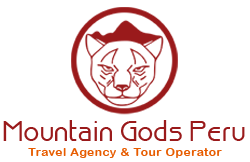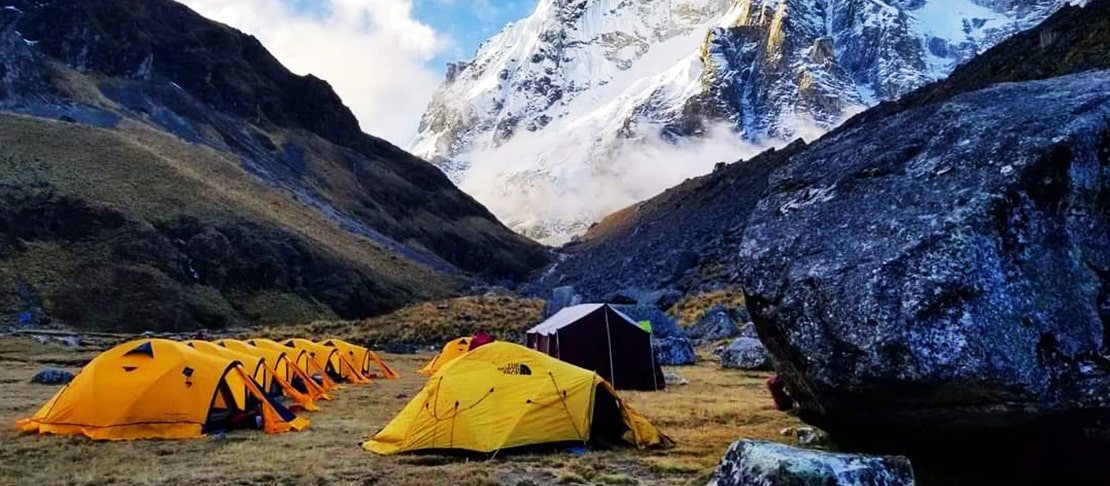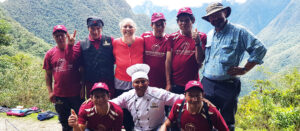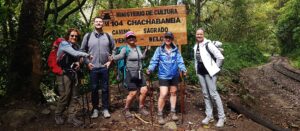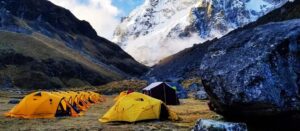This amazing trail runs beneath the magnificent Salkantay mountain (6.271 m/20,569ft), one of the highest and most stunning in the Andes. The Salkantay Trek was recently named on the National Geographic Ultimate Adventure bucket list – defined as “The 20 most extreme, hair-raising, legendary adventures on the planet.” It is a trek open to everybody, and the most popular alternative to the Inca Trail to Machu Picchu, and rich in natural scenery.
This offers 4 days, 5 days of trekking through various landscapes including highlands, cloud forest, rain forest and dry mountain. Throughout the trek you have amazing views of Apu Salkantay, Pumasillo Mountain and Humantay Mountain, three of the most stunning peaks of the Cordillera Vilcabamba Mountain range.
What is Salkantay?
Rising in solitary splendor due south of Machu picchu.Salkantay (6,271m/20,574) is one of the highest and most impressive mountain in the departament of Cusco,and dominates the región of Machu picchu itself visible from great distances,it was highly revered in Inca tlimes and continues to be so today.The name “ Salkantay “prabably stems from the Quechua Word “salcca” (salqa),which means “wild or uncivilized.”
People living near cusco perceive Salkantay as the “brother”of Ausangate .Ausangate (6.372m/20,905’) is the highest mountain in the Department of cusco and only snowcapped mountain visible from the city of cusco .The two mountains are believed by many people to be the “fathers”of all the mountains and to be equally powerful.
These mountains were often the first to be named in rituals in the cusco región ,and their permission is frequently sought before making offerings to the other mountains .When such offerings are made by local communities ,they generally revolve around requests for good weather and increased crop and livestock fertility .When done on the behalf of individuals, the requests are often concerned which health,theft,loss of ítems, or desires for increased prosperity ,success in business.
Salkantay’s importance is not restricted to the área aruond the city of cusco .The anthropologist juan ñunez del prado found it to be a principal mountain deity for the entire Department of cusco and a tutelary deity for the department of Apurimac as well .
One of the earliest references to Salkantay is that of the spanish priest cristobal de albornoz ,who wrote in 1583 that Salkantay was “ very revered.”Another early source , juan de santa cruz pachacuti , wrote that “Salkantay “was one of the mountains to which the “huacas “(sacred places or objects, there referring to various deities ) were banished by the god tonopa (tunupa) In a document of 1697 found in cusco archives , Salkantay was one of the principal mountain deities called upon for curing a man in cusco .Salkantay is still commonly invoked in rituals to cure illnesses in the cusco región .
In the late 1800’s Salkantay was noted as being a male ( called urco Salkantay ) ( urco meaning male or mountain )and his wife was Huaca (or Huacay ) Huillca (Waqaywillca or Veronica),also called China Salkantay ( china meaning female) Interestingly.these names have been also used for the two summits of Salkantay : China Salkantay as the female and Urco Salkantay as the male.
Highlights of the Salkantay Trail:
- Hike through the amazing Vilcabamba mountain range and pass through stunning landscapes varying from the cloud forest to the high mountains.
- Camp on the third night overlooking Machu Picchu
- Pass through so many different micro-climates that your scenery is always changing.
- Most popular of the alternative treks for a good reason.
Weather on the Salkantay:
Of course weather is unpredictable. Typically the dry season in Cusco is from April through October, but this does not stop raining from falling in June or the sun from coming out in December – just be prepared. No matter what month you are doing the trek, please make sure that you have rain gear that includes a waterproof jacket, pants, poncho and waterproof gloves. Many people forget about gloves, but being cold and wet makes hiking very unpleasant.
Also prepare for 4 seasons. Many of the treks through the Andes involve many micro-climates and you will need to be prepared for all seasons. Layers are always key as they are easy to adjust to the different temperatures. And evenings will always be cold, so please be prepared with a warm winter weight jacket.
Altitude in Salkantay:
As soon as people book their trip to Peru, specifically Cusco, they start wondering about altitude sickness. The air at high altitudes contains less oxygen than at sea level and forces your body to work harder to get the oxygen it needs. Over several days at high altitude, your body adjusts to the lower amount of oxygen in the air. This is why we always recommend spending at least two days in Cusco before beginning any trek. If you have more time, even better. Cusco is an amazing city with a lot to do, so you won’t be bored.
With altitude sickness, you may first feel like you have the flu or a hangover. You may have a headache, tiredness, loss of appetite, nausea or vomiting, dizziness, trouble sleeping, trouble breathing during exercise.
Most of the time, these symptoms will be mild. We always recommend easing into activity slowly, allowing your body to adjust. Drink plenty of fluids such as water or coca tea. Coca tea has been used since ancient times to help prevent altitude sickness. Leaves from the coca plant contain alkaloids which helps bring oxygen into your blood, helping your body avoid the effects of altitude sickness. Avoid drinking a lot of alcohol and coffee. They will cause you to urinate more often and become dehydrated. Avoid smoking. Smoking makes it more difficult for your body to get oxygen. Avoid sleeping pills. They may cause shallow breathing at night, making it more difficult for your body to absorb oxygen while you sleep.


